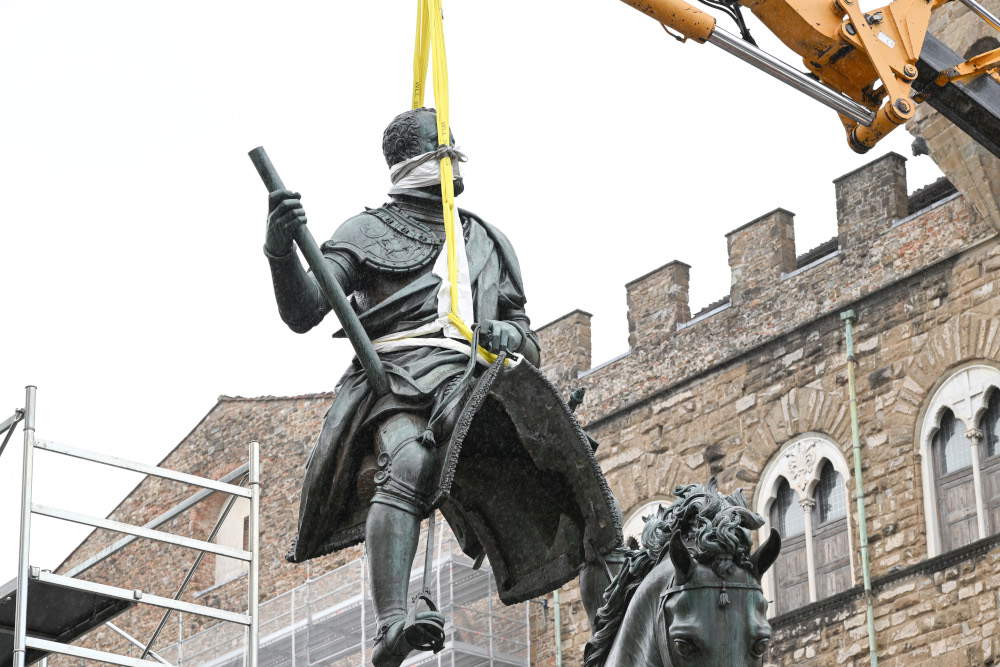At the end of a complex restoration of the equestrian monument of Cosimo I de’ Medici, the masterpiece by Giambologna (Jean de Boulogne; Douai, 1529 - Florence, 1608) located in the center of Piazza della Signoria in Florence, the statue of Cosimo I is back on horseback. The operation of repositioning the horseman was accomplished yesterday with the help of a special crane that allows for the movement of works of art, guaranteeing the utmost delicacy and precision of movement.
Giambologna’s monument was completely restored, removing deposits and surface corrosion products until the stable patinas of the bronze were revealed, then properly coated with multiple layers of protective substances. For a previous disassembly of the equestrian statue of Cosimo I, one has to go back to the time of World War II, when the work was moved to be protected from bombing, while the last external restoration before that was in the 1990s. With these works, however, it was also possible to intervene inside the figure of the grand duke and the horse, where the problems of corrosion of the reinforcing bars inside the horse’s legs, whose advanced deterioration had been highlighted by the investigations carried out, were solved, and then consolidate the tail as well. During the operations, the statue of the horse was further raised: this allowed the necessary restorations to be made to the base by intervening in the areas supporting the horse itself; parts irreparably damaged by the interventions carried out during World War II to disassemble and then relocate the work.
To ensureadequate stability for the monument-simply consider that the entire bronze group weighs more than 10,000 kilos, 7,800 the horse and 2.300 the horseman -, a stainless steel plate was inserted into the top of the plinth, immediately underneath the finishing marbles, which made it possible to connect the front support leg with the rear one as originally intended by Giambologna; the system for attaching the horse to the plinth was also made entirely of stainless steel material, so as to ward off corrosion problems in the future. Moreover, this system is reversible and will be able to allow in the future to remove the horse from the plinth with few mechanical operations, without risk of damage to the bronzes and marbles, respecting the idea implemented by Giambologna in 1594.
“This latest intervention concludes the cycle of restoration of all the sculptural complexes in the most beloved square of Florentines, Piazza Signoria,” said Florence Mayor Dario Nardella. “A 10,000-pound statue, a spectacular intervention, for which the best restoration techniques were used starting with a very high-precision crane. We are very happy and thank the Technical Services Directorate and the Fine Arts Office, the Ferragamo company, the Superintendency, and all the restorers. Giambologna’s work will shine again, and so will Cosimo I, whose 450th anniversary of his death will fall next year.”
In the coming days, the three bronze bas-reliefs of the base and theepigraph, also in bronze, will also be relocated, for which it was possible to heal and protect their backs in contact with the base, as well as the lateral coats of arms, for which some missing details were reversibly reintegrated with appropriately pigmented resin molded elements.
The restoration of Giambologna’s equestrian monument constitutes thelast stage of work on the sculptural groups in Piazza Signoria. As with the other statues (Hercules and Cacus, Termini, copy of David, copy of Judith) and the bronze David sculptural group in Piazzale Michelangelo, the work was desired, designed and commissioned by the City of Florence and carried out thanks to an agreement with the Florentine fashion house Salvatore Ferragamo S.p.A., which, through Art Bonus, gave a liberal disbursement of more than one million euros in total. The work was carried out by Cooperativa Archeologia, in collaboration with restorers Nicola Salvioli, for the bronze parts, and Stefano Landi for the marble works.
The work was designed and directed by technicians from E.Q. Palaces, Villas and City Monuments of the City’s Fine Arts Service, with high supervision by the SABAP Soprintendenza Archeologia Belle Arti e Paesaggio (art historian official dr.ssa Lia Brunori), with support from the CNR (National Research Council), University of Florence DST-LAM (Department of Earth Sciences, Materials Laboratory, Applied Geology, Environment and Landscape) and from the Thierry Radelet Laboratory for diagnostic investigations, while engineer Leonardo Paolini took care of the aspects related to the lifting and relocation of the horse together with the two firms specializing in handling works of art Arteria and AlterEgo.
 |
| Florence, reassembled the equestrian monument of Cosimo I, a masterpiece by Giambologna |
Warning: the translation into English of the original Italian article was created using automatic tools. We undertake to review all articles, but we do not guarantee the total absence of inaccuracies in the translation due to the program. You can find the original by clicking on the ITA button. If you find any mistake,please contact us.